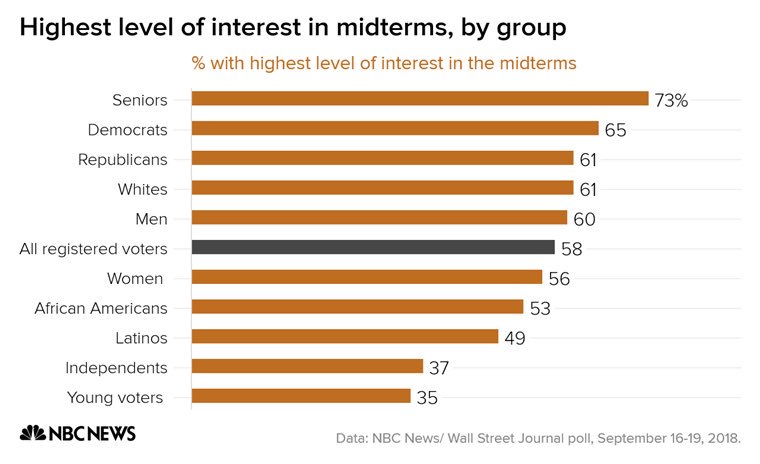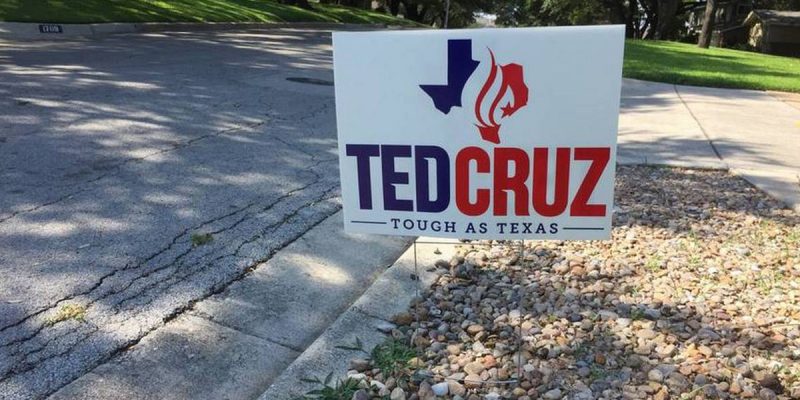Formerly, RCP had the race listen as a tossup, but with a couple of polls out last week from CBS News/YouGov (50-44 for Cruz) and Emerson (49-42 for Cruz), they’ve moved the Texas Senate race toward the red side.
From that CBS News/YouGov poll, some interesting information in the crosstabs…
- Cruz leads among men but they are tied among women. O’Rourke leads in the 18-29 age group but Cruz leads in the 30-44, 45-64 and 65+ age groups.
- Cruz leads among independents 46% to 44%.
- Top 3 issues are immigration, gun policy and taxes.
- 63% of Texans feel illegal immigration is “a big problem”.
- 52% of voters feel Cruz “is honest and trustworthy” while 48% feel the same about O’Rourke. 48% of voters feel Cruz “is someone I can relate to” while 44% feel the same about O’Rourke.
- 51% of respondents feel the GOP treats the interest of whites and minorities the same way while 43% feel the same about the democratic party.
- 30% of respondents said the Texas Senator should support Trump as much as they can while 24% said the Texas Senator should oppose him as much as they can.
- 35% of respondents say the election is not about Trump while 34% say their vote is to support Trump and 31% plan to vote to oppose Trump.
- Cruz leads O’Rourke is all policy areas polled (Health care, immigration, crime and gun policy).
- 94% of respondents have already made up their mind for a candidate (strong-very strong support).
- 85% of respondents view the economy as somewhat good-very good while 15% view it as somewhat bad-very bad.
O’Rourke is attempting to quell Cruz’ surge, which has come mostly on the strength of a crushing debate performance at O’Rourke’s expense and increasing voter understanding of just how left-wing O’Rourke is, by barnstorming college campuses across Texas.
Jaren Lynch lingered Tuesday in the emptied auditorium at Austin Community College’s Eastview campus, where Democratic U.S. Senate candidate Beto O’Rourke, launching a 12-campus college tour, had brought the students to their feet.
“I loved it,” said Lynch, who had never seen O’Rourke in person, before adding, “I thought we were going to do a meet-and-greet. I’m pretty sad about that.”
O’Rourke, a three-term congressman, had quickly exited to catch a flight to his hometown El Paso, a last respite with his wife and kids before the final sprint to Election Day.
“I registered to vote this year just for him,” said Lynch, wearing her white-on-gray “Beto for Texas” shirt. “I’ve never voted before, and I’m 34. I’m pretty ashamed of that. And, I signed up 23 of my family members to vote. I signed up three waitresses from Chili’s the other day. I’m not part of the campaign organization, but I’m having so much fun. It’s really cool.”
If Beto O’Rourke wins in November, it will be because of the likes of Lynch.
O’Rourke, seeking to unseat U.S. Sen. Ted Cruz, R-Texas, has drawn phenomenal crowds, stirred tremendous excitement, generated glowing news coverage and raised more money — a lot more, than Cruz and any other U.S. Senate candidate in the country.
Yet, O’Rourke’s long-shot candidacy will rise or fall on a spontaneous get-out-the-vote effort that hopes, beginning Monday and for the remaining month before Election Day, to harness and train enough volunteers to knock on the doors of as many as possible of the 5.5 million Texans it has identified as likely to vote for O’Rourke — if they vote. The campaign’s ambition is to draw a million more Democratic votes for O’Rourke than the party’s candidates in recent past midterm elections, surpassing their margin of defeat.
If you read the Statesman article, there’s a good set of quotes from Gov. Greg Abbott’s political strategist Dave Carney, who’s been around Texas politics forever and knows what he’s talking about. Carney doesn’t disparage O’Rourke’s campaign to an obnoxious extent, but what he does say is what O’Rourke is doing isn’t likely to work.
“No question, they’ve done a lot of smart things in their campaign — but this in particular does not frighten us,” Abbott strategist Dave Carney said of the O’Rourke campaign. “They’re just late. They’re not going to be dollars short. They’ve got plenty of dollars. But they are days late. This is something they should have started really before the primary.”
“Doing a turnout campaign in the last 30 days of the campaign is what losing campaigns do,” Carney said.
“They just don’t have the infrastructure and the depth of knowledge. We have been building our voting file since 2012. We didn’t close down our operation. We kept our field operation intact throughout the entire four years,” Carney said. It has been an ongoing, carefully tended effort that has identified 3 million base Republican voters who only need a gentle reminder to go vote, and another 3 million friendlies who will need more of a nudge to make sure they vote and will get it.
…
But, Carney said, the big numbers among new registrants are newcomers from other states and those moving within Texas — and the Abbott campaign assiduously tracks and contacts with them as registration information becomes available. By the Abbott campaign’s count, between the March primary and the end of August, Carney said, “more Republican-leaning voters have registered to vote in Texas than Democratic voters.”
“Many are in the middle. It’s not like they’re all hard-core conservatives, but they hew to the right side of the scale, not the left side of the scale,” Carney said.
From O’Rourke’s game plan: “There’s a common misconception that elections are mostly decided by so-called swing voters — voters who can be persuaded to vote for one candidate or the other — and that campaigns should focus all of their energy on people who make up their mind in the final weeks of an election. We hear this argument a lot in Texas. You’ve probably heard it from someone you know or from some skeptical media pundit: ‘Sure, people are excited about Beto, but there just aren’t enough swing voters in Texas for him to win.’
“But, if you do the math, it turns out that’s not true. The truth is that Texas is not a red state. It’s a nonvoting state. The key to winning this election is increasing voter turnout. Getting people off the sidelines, engaged, and in the game.”
Carney said the view that Texas is not a red state but a nonvoting state, has become an “absolutely sacred belief” among Texas Democrats.
But, he said, it’s wrong.
“We’ve actually taken the time to talk to these nonvoters and assess them and model them,” Carney said. And, of these Texans, “there are more conservative, right-of-center nonvoters than there are Democrats.”
“The reality is the majority of the 7 million voters who never vote, the majority of them are for us,” Carney said. “We’re trying to get them in interested in this race.”
O’Rourke might be an outlier and he might be the one candidate who brings in a massive wave of left-leaning college kids who’ll vote for him unlike in past elections. That’s certainly his aim. But here’s the problem – if Texas is anything like the rest of the country, and in this respect there isn’t much reason to believe it’s very different, O’Rourke is aiming at the wrong voters if he wants to win a turnout victory.
Advertisement

That’s a poll from three weeks ago, before the dramatic conclusion to the Brett Kavanaugh confirmation battle and the falling-apart of the allegations against him which have resulted, poll after poll seems to show, in a turbocharging of Republican voter interest in the elections. You’ll notice the least interested voters of the bunch are the young crowd O’Rourke is trying to focus on by pushing Hard Left policies favored on campus and hated most everywhere else.
We’re going to predict RCP isn’t done moving the Cruz-O’Rourke race in its classifications. But it won’t be moving the race back to “Toss-Up.”
Advertisement
Advertisement


